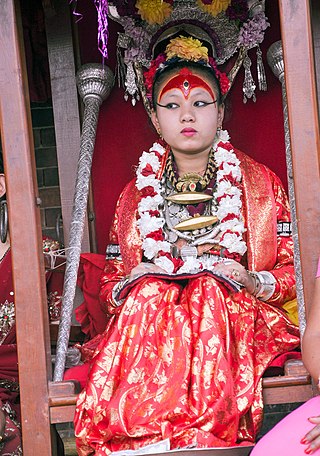
Kumari, Kumari Devi, or the Living Goddess is the tradition of worshipping a chosen virgin as manifestations of the divine female energy or Shakti in Dharmic Nepali religious traditions. It is believed that the girl is possessed by the goddess Taleju or Durga. The word Kumari is derived from Tamil "குமரி" meaning Young girl. The procession is akin to Indra or Sakra, taking Indrani to his celestial abode as his bride. The festival is celebrated during Kumari Jatra, which follows the Indra Jatra religious ceremony.
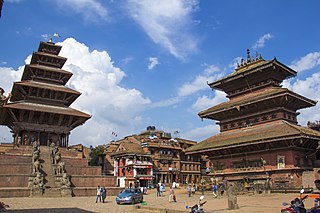
Bhaktapur, known locally as Khwopa and historically called Bhadgaon, is a city in the east corner of the Kathmandu Valley in Nepal located about 13 kilometres (8.1 mi) from the capital city, Kathmandu. Bhaktapur is the smallest city of Nepal as well as the most densely populated. Along with Kathmandu and Lalitpur, Bhaktapur is one of the three main cities of the Kathmandu Valley and is a major Newar settlement of the country. The city is also known for its Newar tradition, cuisine and artisans. Bhaktapur suffered heavy damage in the April 2015 earthquake.

Newar, or Nepami, are primarily inhabitants in Kathmandu Valley of Nepal including its surrounding areas and the creators of its historic heritage and civilisation. The Newar are a distinct linguistic and cultural group, primarily Indo-Aryan and Tibeto-Burman ethnicities, who share a common language, Nepal Bhasa, and predominantly practice Newar Hinduism and Newari Buddhism. Newars have developed a division of labour and a sophisticated urban civilisation not seen elsewhere in the Himalayan foothills.

Tāmrakār is a caste of coppersmiths and other metal casters found in Nepal and India. In Nepal, the Tamrakars are found among the Newar community of the Kathmandu Valley.
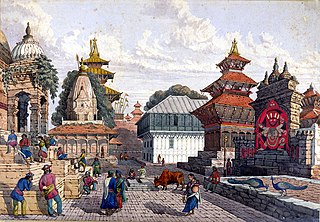
The Malla dynasty also known as the Malla confederacy, was the ruling dynasty of the Kathmandu Valley in Nepal from 1201 to 1779. This dynasty was founded by Arideva Malla. Though the latter Mallas were regarded as belonging to the Raghuvamsha dynasty, they were also seen as continuations and descendants of the Licchavi dynasty. Later Malla kings also traced one section of their lineage from Nanyadeva, the founder of the Karnat dynasty of Mithila. The term malla means wrestler in Sanskrit. The first use of the word malla in the Kathmandu Valley began in 1201.
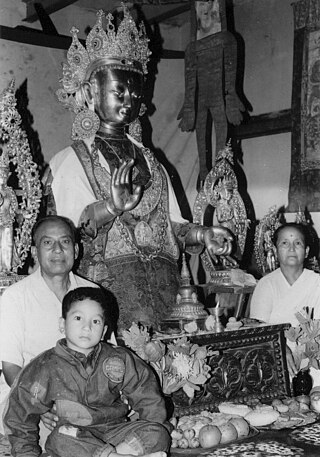
Tulādhar is a Nepali/Nepalese caste from the Newar community of the Kathmandu Valley in Nepal. The name Tuladhar is derived from the Sanskrit words "tula" and "dhar" (possessor), thus meaning scale-bearer or in general, merchant. Tuladhars belong to the Uray group which includes Kansakar, Tamrakar, Sthapit, Bania, Sindurakar, Selalik and other castes. They follow Newar Buddhism and speak Nepal Bhasa as a mother tongue.

Gai Jatra, also known by its endonym Sa Paru, is a Nepalese festival celebrated mainly in the Kathmandu valley by the Newar people. The festival is celebrated in honour of their immediate relatives who have died during the previous year. Various groups of children dressed up as cows and in other religious drags are organized throughout various cities.

Madhyapur Thimi, also known as Thimi, is a municipality in Bhaktapur District in the Bagmati Zone of central Nepal. Thimi lies between Kathmandu, Lalitpur and Bhaktapur in the Kathmandu Valley. It is one of the ancient cultural and historical places along the trade route from Bhaktapur to Kathmandu. The city is situated on elevated land and occupies an area of 11.47 square kilometres (4.43 sq mi), divided into nine administrative wards.

Asan is a ceremonial, market and residential square in central Kathmandu, the capital of Nepal. It is one of the most well-known historical locations in the city and is famed for its bazaar, festival calendar and strategic location. Asan has been described as a fine Newar example of a traditional Asian bazaar. The Tuladhar, Maharjan, Shrestha, Bajracharya and Shakya castes make up most of the population.

Jitamitra Malla was a Malla Dynasty King of Bhaktapur, Nepal from 1673 till his abdication in 1696. He was also known by his nom de plume, Sumati, meaning "the wise one".

Bhaktapur Durbar Square is a former royal palace complex located in Bhaktapur, Nepal. It housed the Malla kings of Nepal from 14th to 15th century and the kings of the Kingdom of Bhaktapur from 15th to late 18th century until the kingdom was conquered in 1769. Today, this square is recognised by UNESCO, managed jointly by the Archeological Department of Nepal and Bhaktapur Municipality, and is undergoing extensive restoration due to the damages from the earthquake in 1934 and the recent earthquake of 2015.
Rajopadhyaya also called Newari Brahmin is the main division of Newar Brahmins in Nepal. The Rajopadhyayas claim to be originated in Kānyakubja or modern day Kannauj, in the north of India, a city with a prestigious history from where the Bahuns also claim to come. They along with Bahuns claim to be sub-division of Kānyakubja Brāhmins.

Indra Jātrā, also known as Yenyā Punhi is the biggest religious street festival in Kathmandu, Nepal. "Ye" means the old Newari name for "Kathmandu", "Ya" means “Celebration”, and "Puhni" means full moon so together means the birthday of the old city of Kathmandu. The celebrations consist of two events, Indra Jātrā and Kumāri Jātrā. Indra Jātrā is marked by masked dances of deities and demons, displays of sacred images, and tableaus in honor of the deity Indra, the king of heaven. Kumāri Jātrā is the chariot procession of the living goddess Kumari.

Kansakār or Kasāh (कसाः) is a Nepalese caste group belonging to the Newar community of the Kathmandu Valley in Nepal. In Sanskrit, Kansakar means bronze worker, and their traditional occupation has been metal working and trading. Today, they are merchants, industrialists and professionals.

Kumha Pyakhan is a sacred dance of the Tuladhar and Kansakar caste groups of the Newars of Kathmandu. The dance is performed in temple and market squares during religious festivals.

Jana Bahā Dyaḥ Jātrā is the chariot procession of Jana Baha Dyah, the Bodhisattva of Compassion, which is held annually in Kathmandu. It begins on the 8th day and ends on the 10th day of the bright fortnight of Chaulā (चौला), the sixth month in the lunar Nepal Era calendar.
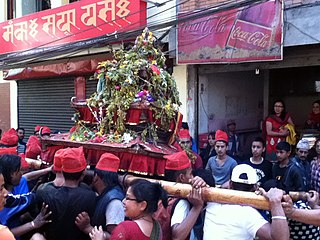
Pāhān Charhe also known as Pāsā Charhe is one of the greatest religious festivals of the year in Nepal Mandala. It is celebrated with particular fervor in Kathmandu, and consists of a conglomeration of activities including parades, masked dances, horse racing and religious worship held over three days in different places.

Kaulā is the twelfth month in the Nepal Era calendar, the national lunar calendar of Nepal. The month coincides with Ashvin (अश्विन्) in the Hindu lunar calendar and October in the Gregorian calendar.

Dance is a performing art form consisting of purposefully selected sequences of human movement. Dance (Nepali: नृत्य/ नाच) in Nepal comprises numerous styles of dances, including folk, ethnic, classical to modern dances. Lakhey is the dance of a demon in the carnival of God. Durbar Square, a historic plaza in Kathmandu, Nepal, facing ancient palaces and adorned by Hindu temples, is always full of eager crowds on the last day of Indra Jatra, the festival celebrating Indra, the Hindu king of heaven. In this divine stage, Lakhe the demon dances among gods and deities relentlessly and carelessly.























